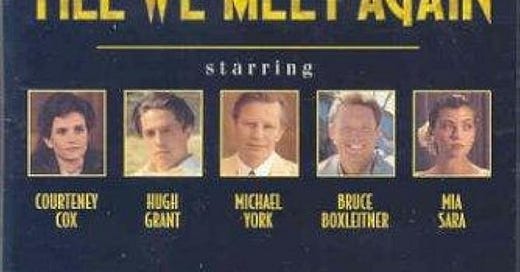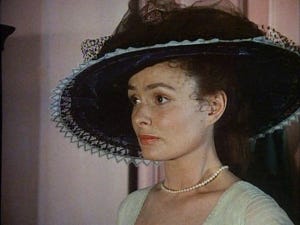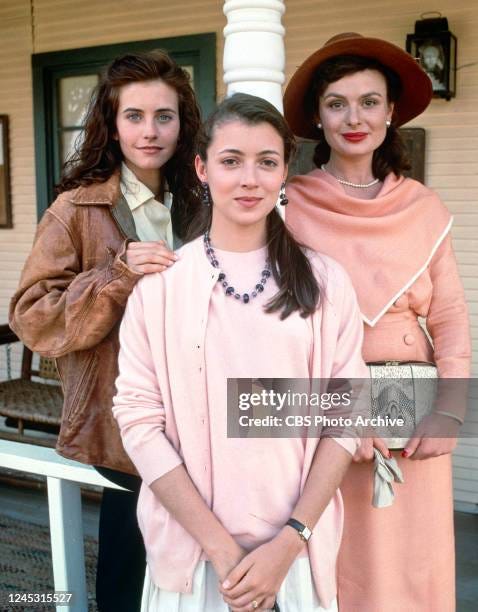
This week, we were inundated with coverage and hot takes on Donald Trump’s first 100 days back in the White House. I don’t know about you, but since I’ve got nothing to celebrate on that front and I’m suffering from serious political burnout, I decided to do something fun for this week's post instead. I'm tapping into my past as a TV journalist and recapper to introduce (or perhaps reintroduce!) you to one of my favorite guilty pleasures: Till We Meet Again -- a sweeping, frothy miniseries from 1989 based on Judith Krantz’s novel of the same name.
Baby Gen-Xers such as myself were raised on these multi-night television events, and I vividly remember watching Till We Meet Again during its initial broadcast when I was 12. Over the years, I rediscovered it through evolving forms of media: Basic-cable rebroadcasts, Netflix DVD rentals, and now, bootlegged versions on YouTube. Unfortunately, even in the age of streaming, TWMA isn’t readily available besides the aforementioned YouTube options. (The DVD set is available on Amazon, but I am not encouraging anyone to fill Jeff Bezos’ pockets to unlock a core memory.)
Meet the de Lancels
Till We Meet Again is the multigenerational saga of the de Lancel family, wealthy aristocrats and proprietors of one of France’s most prestigious champagne houses. While the story is purportedly female-centric, focusing on the de Lancel matriarch, Eve, and her two daughters, Cabaret and Romeo and Juliet star Michael York receives top billing as patriarch Paul de Lancel. Ah, 1989.
The story begins by ramming the term “headstrong women” down our throats at the very first scene: Eve Coudert (Lucy Gutteridge; Eighties kids will recognize her as Val Kilmer’s love interest in Top Secret) is a well-bred doctor’s daughter in pre-World War I Dijon, who is so over her stuffy life that she runs away to Paris with a sketchy song-and-dance man (Grease 2’s Maxwell Caulfield), scandalizing her family.
Desperate for money and discarded by her lover, Eve does what any scrappy girl in a 1980s miniseries would do: She becomes a music hall star!
Through the chaos of WWI, Eve meets York’s character, the dashing Paul de Lancel, and swiftly trades in music hall stardom for a comfortable life as a diplomat’s wife.

Once we get to the 1930s, the narrative moves to Paul and Eve’s — you guessed it, headstrong — daughters. Now living in California, Delphine (Mia Sara) is a sophisticated, albeit directionless, party girl, and her younger sister Marie-Frederique, aka “Freddy” (Courteney Cox), is a fearless aviatrix sleeping with her much-older mentor (Barry Bostwick).
(Although most characters are supposed to be French, Cox and Sara get away with their American accents because Delphine and Freddy spend their formative years in the U.S.)
Throw in nonstop tragedy, World War II, numerous male love interests, breathtaking locales (Southern California beaches! English country estates! French vineyards!), and a nefarious villain played to the mustache-twirling hilt by a baby-faced Hugh Grant — and you’ve got the quintessential late-1980s American TV miniseries.
We do have to talk about Bruno
The number-one reason to watch Till We Meet Again is the actors, full stop. The cast list reads like a Gen-X fever dream: We have a post-"Dancing in the Dark" video, pre-Friends Courteney Cox as Freddy. As Delphine, there’s Mia Sara, fresh off her Ferris Bueller’s Day Off success (she played Ferris’ girlfriend Sloane Peterson). And before he delighted audiences as The Nanny’s Mistah Sheffield, Charles Shaughnessy rocked an inexplicably anachronistic mullet as cinematic genius Armand Sadowski, the Jewish man who captures Delphine’s heart.
But the true star of Till We Meet Again is Hugh Grant, who makes an absolutely delicious meal of his role as Nazi collaborator Bruno de Lancel, Paul’s estranged son from his first marriage.
For context, Till We Meet Again premiered five years before Grant broke out as a rom-com leading man in Four Weddings and a Funeral. So it’s not like viewers were all, “What the hell happened to that stammering English boy with the floppy hair and morning suits?” No one knew who Grant was at the time, which is probably for the best, considering he played a colossal douche — and not the charming kind.
We meet Grant’s Bruno as a young, French student in the late 1930s who idolizes Hitler (big red flag). Oh, right, he also despises his father — and stepmother, Eve — due to a ginormous heap of childhood trauma:
Bruno’s mother (Paul de Lancel’s first wife) died by suicide when Bruno was a baby. A pampered aristocrat living in a world with nonexistent mental health care, Maman couldn’t handle her husband fighting in the First World War. So she shot herself in the head.
Since Bruno’s maternal grandparents blamed Papa Michael York for their daughter’s suicide, they poisoned their grandson against Paul and kept the two apart until Bruno reached adulthood. Grandmère and Grandpère also filled Bruno’s head with cruel rumors about Daddy’s second wife being a floozy.
But none of Bruno’s emotional damage excuses anything he does in this miniseries. The guy is a monster, period.
First, he collaborates with the Nazis when they invade France, draining the family champagne fortune — and committing murder — to save his neck.
He then berates Delphine for daring to fall in love with a Jewish man, pimps her out to a German officer, and when she refuses the Nazi’s advances, BRUNO RAPES HER. That’s right, Bruno rapes his half-sister.
Funny sidenote: Hugh Grant does remember this trainwreck of a role, though not which half-sister his character sexually assaulted. He chatted about Till We Meet Again on Marc Maron's “WTF” podcast in 2021, adorably referring to it as one of the “dodgy miniseries” he did early in his career. But he mistakenly says his character raped Courteney Cox (it was Mia Sara).
Listen to him wax poetic about his “evil champagne baron” character here, at around 31:39:
Bruno continues his hateful rampage against his family after the war, culminating in a) him literally spitting on his father’s grave and b) evicting his stepmother and half-sisters from their chateau. But it’s a pyrrhic victory: Bruno receives his much-deserved comeuppance shortly afterward — because this is a TV miniseries based on a beach read, and the audience deserves a happy ending:
The curse of the underwritten women
Till We Meet Again may be a story about women, but it suffers from the curse of the underdeveloped female characters. (An occupational hazard when a trashy novel is the source material, even if a woman is the author.) Weirdly enough, Bruno, despite being an odious scoundrel of the highest degree, has a more captivating backstory than Eve, Delphine, or Freddy.
The de Lancel women do go through a lot, but there’s still too much emphasis on their outer beauty and not enough on how they must always rise above their trauma instead of addressing it directly. All three characters are valedictorians of Sweep-It-Under-the-Rug School, which does them all a giant disservice. Delphine’s sexual abuse is barely discussed; we’re supposed to accept that Delphine is fully healed after a single conversation with her husband, Armand. Freddy, meanwhile, seems destined to a life of bitterness — and a fear of flying — following multiple plane-related tragedies.
Freddy eventually gets back into the pilot seat, but it’s not because she’s suddenly conquered her fear. Oh, no, she only learns to be happy again because she’s accepted another man’s love into her heart. Once that happens, the miniseries can wrap itself up into a tidy little Hollywood bow.
At the same time, Eve, Delphine, and Freddy are worth our admiration too: For a well-to-do teenager in 1913 France, Eve took a big swing by running off with a lover and abandoning her traditionalist family because she wanted more out of life. I think it’s pretty cool that she became a music hall star in her own right — just in time to dump her loutish lover.
Delphine not only becomes a successful French actress, but she also defies society’s attitudes of the day by remaining faithful to her Jewish fiancé throughout the war, marrying Armand after the Nazis nearly killed him. Freddy is the coolest of all, though, serving as a pilot in the Second World War, then starting her own postwar business! Sure, her useless, hoity-toity British husband gets bored and divorces her, but what’s a TV miniseries without big breakup drama?
But I’m not here to extol the virtues of Till We Meet Again’s narrative or character development, because they’re both weak and one-dimensional. Besides, that’s not why this miniseries won me over.
Sometimes, you want to just sit back, relax, and watch a few familiar faces chew the scenery in gorgeous, period-accurate clothes. If they also remind you that Nazis are the bad guys, then so much the better.
Because even in 2025, we still need that reminder.
Till We Meet Again is currently available on YouTube:







